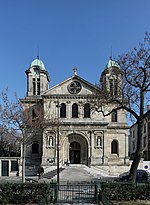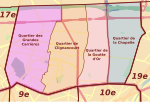Rosa Parks station (Paris)
Buildings and structures in the 19th arrondissement of ParisMemorials to Rosa ParksRailway stations in France opened in 2015Réseau Express Régional stationsWikipedia page with obscure subdivision

Rosa Parks station (French: Gare Rosa Parks) is a railway station in the 19th arrondissement of Paris, France near the Porte d'Aubervilliers. It is on the RER network, and also has a tram stop. The station opened on 13 December 2015, and bears the name of American civil rights activist Rosa Parks.
Excerpt from the Wikipedia article Rosa Parks station (Paris) (License: CC BY-SA 3.0, Authors, Images).Rosa Parks station (Paris)
Rue Gaston Tessier, Paris 19th Arrondissement (Paris)
Geographical coordinates (GPS) Address Nearby Places Show on map
Geographical coordinates (GPS)
| Latitude | Longitude |
|---|---|
| N 48.896388888889 ° | E 2.3741666666667 ° |
Address
Rue Gaston Tessier
75019 Paris, 19th Arrondissement (Paris)
Ile-de-France, France
Open on Google Maps










